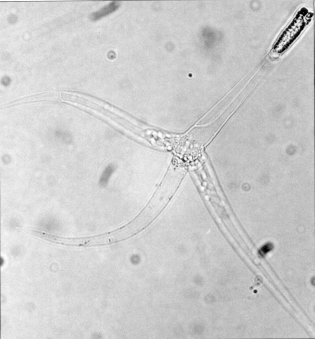RenegadeInterrupt
Anarcho-Centrist Judeo-Satanic Imperialist
Next book I plan on writing is going to be a deep-sea sci-fi horror inspired by films such as Deep Star Six and Leviathan (both released the same year of 1989 funnily enough), with obvious nods to the first Alien film and its knockoffs such as "Creature" and the "Xtro" films (particularly Xtro II) - i.e. big scary monster picking off people one by one in a confined space. Haven't thought of a name for it, I might just call it "the organism" to maintain its mystery and reduce cringe. I'm sure if it ever gets made into a film it'd look different in the finished product, but for its adult stage I imagine essentially a giant, mutant Portuguese man o' war, something like so (not my work):

Only instead of being venomous it emits a frequency/wavelength that accelerates maritime hallucinations and nitrogen narcosis, while essentially being a massive shapeshifting colony organism in its parasitic larval/pupa stage that responds to changes in blood pressure and heart rate (and it can almost 'sense' what you're most afraid of), which begins immediately as soon as its eggs/spores make it inside of you (it shares similarities with slime mold in this stage, and has regenerative abilities like slime mold, also a reference to the EU xenomorph ability of regeneration) at which point they begin to multiply and form an egg sack that grows and multiplies as it converts all surrounding tissue into new egg sack, after a certain point it enters stage 2 of the infection once the host is essentially a giant reproductive organ and eventually results in stage 3, the gestalt or "adult" stage, in which a brand new colony organism is produced that is morphologically similar to a Portuguese man o' war or other siphonophores, only the lore indicates that it is more akin to a "proto-siphonophore", an ancestor relative, not a sibling. I'm still working on the lore but basically it begins with the collision of the oceanworld Theia with Earth 4.5 billion years ago, the origin of water - and thus life itself - on Earth. Essentially all life in our oceans evolved from this organism.
What would/should be some of the other feats of this organism? I've read that similar organisms can even form an exoskeleton, such as corals.
Edit: Also if you think you have a cooler name for it than "the organism" by all means. I jokingly call it the "ooze golem" since it is found in sediment and its shapeshifting abilities in its larval/pupa stage.
Edit 2: Perhaps it would be more accurate to refer to its stage 2 form as a "pupa", as opposed to a larva, as its larval form would be microscopic and look something like this:


Only instead of being venomous it emits a frequency/wavelength that accelerates maritime hallucinations and nitrogen narcosis, while essentially being a massive shapeshifting colony organism in its parasitic larval/pupa stage that responds to changes in blood pressure and heart rate (and it can almost 'sense' what you're most afraid of), which begins immediately as soon as its eggs/spores make it inside of you (it shares similarities with slime mold in this stage, and has regenerative abilities like slime mold, also a reference to the EU xenomorph ability of regeneration) at which point they begin to multiply and form an egg sack that grows and multiplies as it converts all surrounding tissue into new egg sack, after a certain point it enters stage 2 of the infection once the host is essentially a giant reproductive organ and eventually results in stage 3, the gestalt or "adult" stage, in which a brand new colony organism is produced that is morphologically similar to a Portuguese man o' war or other siphonophores, only the lore indicates that it is more akin to a "proto-siphonophore", an ancestor relative, not a sibling. I'm still working on the lore but basically it begins with the collision of the oceanworld Theia with Earth 4.5 billion years ago, the origin of water - and thus life itself - on Earth. Essentially all life in our oceans evolved from this organism.
What would/should be some of the other feats of this organism? I've read that similar organisms can even form an exoskeleton, such as corals.
Edit: Also if you think you have a cooler name for it than "the organism" by all means. I jokingly call it the "ooze golem" since it is found in sediment and its shapeshifting abilities in its larval/pupa stage.
Edit 2: Perhaps it would be more accurate to refer to its stage 2 form as a "pupa", as opposed to a larva, as its larval form would be microscopic and look something like this:

Last edited:


